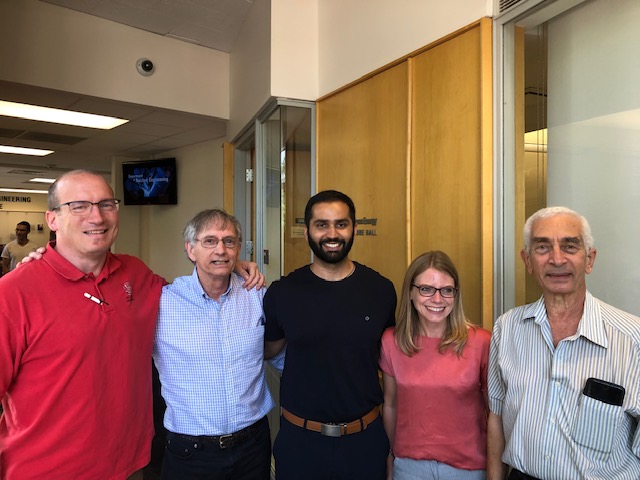On July 1, Abdullah Zafar successfully defended his PhD dissertation, Stark Broadening Measurements at Low Plasma Densities using Doppler-free Saturation Spectroscopy in a Helium Discharge. Abdullah’s committee consisted of his advisor, Steven Shannon, and members, Elijah Martin, John Thomas, Katharina Stapelmann, and Mohamed Bourham.
Abstract
ZAFAR, ABDULLAH. Stark Broadening Measurements at Low Plasma Densities using Doppler-free Saturation Spectroscopy in a Helium Discharge. (Under the direction of Dr. Steve Shannon.)
Stark broadening has been used to extract plasma density (ne) from spectroscopic measurements for decades. This method has been highly advantageous for plasmas that are inaccessible to probes or have harsh environments. Due to Doppler and instrument broadening in passive measurements, the application of this method has been limited to stellar and fusion core plasmas, which typically have ne>1014 cm-3. This is commonly accepted as the Stark broadening limit. However, with the advent of laser spectroscopy, Doppler-free techniques are now available that can greatly reduce both Doppler and instrument broadening. Employing such techniques, the Stark broadening limit can be lowered down to ne=1010 cm-3. This allows Stark broadening to be applied to laboratory and fusion edge plasmas, a diagnostic method unavailable to them previously. Additionally, it enables the study of Stark broadening low plasma densities, which has been largely unexplored.
This work utilizes Doppler-free saturation spectroscopy to measure Doppler-free, Stark broadened spectral profiles for the p-polarization of the HeI 23PŠ53S and 21PŠ61D transitions. Experiments were conducted in a low density (ne=2.23´1010 – 1.71´1012 cm-3) helium plasma. The measurements were performed in an electron-cyclotron resonance discharge at 23, 39, and 54 mTorr with electron density being diagnosed using a combination of Langmuir probe and microwave interferometry techniques. Laser absorption spectroscopy was implemented to determine the gas temperature among a number of other parameters. The 23PŠ53S transition was observed to show excellent agreement with the impact approximation, diagnosing electron density down to ne=4.47´1010 cm-3 with an accuracy of 86% and up to ne=1.71´1012 cm-3 with an accuracy of 17%. Due to the large extent of the measurement volume, integration effects were observed to play a large role at for ne<1011 cm-3 but negligible for ne>1012 cm-3. Quasistatic effects, as predicted by simulations, were negligible. The 21P!61D transition, on the other hand, aligned rather well with quasistatic theory. Electron densities were diagnosed down to ne=7.1´1010cm-3 with an accuracy of 28% and up to ne=1.71´1012 cm-3 with an accuracy of 3%. Impact theory was observed to disagree in magnitude and trend with the Lorentzian broadening extracted from the fits. It was determined that traditional criteria used to evaluate the applicability of the quasistatic and impact Stark broadening models is not accurate. These criteria are reconsidered and new criteria are presented.

